Menus
The last of the line
The ultimate expression of ELF’s motorcycle design philosophy was theELF5, itself an evolution of the unsuccessful ELF4 and which allowed Ron Haslam to finish 11th in the World 500 GP Championship in 1988 with two seventh places at Spa-Francorchamps and Brno as the best results. As he finished in the final table ahead of Randy Mamola (whose Cagiva was handicapped by Pirelli tires) and Patrick Igoa on the 1987 Yamaha V4, ELF could rightly claim that his goal had been achieved by proving that its line of alternative motorcycles started in 1978 and now equipped with Honda NSR500 V4 engines from 1987, was able to compete with factory machines of conventional design. To what extent was this due to Haslam’s determined piloting? We’ll never know. But the fact that Ron suffered from a stomach ulcer for most of the season makes his results, and those of ELF5, even more commendable..
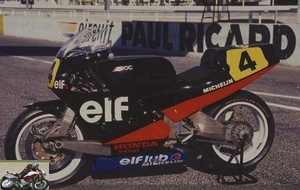 Grand Prix ELF5 test
Grand Prix ELF5 test
Having driven most of the previous ELF models at one point or another, I was eager to taste the evolutions of the last of the line, especially since I had previously been able to test Wayne Gardner’s NSR500, sacred with the same engine as the ELF5 but using a more conventional chassis. The farewell to the Grands Prix organized by ELF on the Paul Ricard circuit at the end of the 1988 season gave me this opportunity. The experience was all the more interesting as it allowed to ride alongside Ron Haslam, the man who led the French team to GP 500 success during the three previous seasons..
Discovery
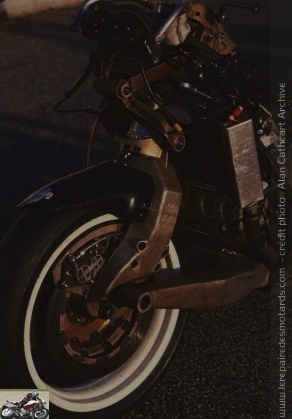 ELF motorcycles are divided into two large families: the range designed by Andre De Cortanze up to the ELF2, with two parallel front swing arms and the series designed from the ELF3 with its front axle inspired by the MacPherson automotive system , imagined by team leader Serge Rosset and produced by Dan Trema. The latter was also responsible for all ELF designs, including the early prototypes of De Cortanze. The ELF5 is therefore based on the ELF3 powered by the NS500, with a separate frame, a single front swing arm and a vertical strut with two articulated wishbones incorporating the single front suspension element (a Showa shock absorber on the ELF5).
ELF motorcycles are divided into two large families: the range designed by Andre De Cortanze up to the ELF2, with two parallel front swing arms and the series designed from the ELF3 with its front axle inspired by the MacPherson automotive system , imagined by team leader Serge Rosset and produced by Dan Trema. The latter was also responsible for all ELF designs, including the early prototypes of De Cortanze. The ELF5 is therefore based on the ELF3 powered by the NS500, with a separate frame, a single front swing arm and a vertical strut with two articulated wishbones incorporating the single front suspension element (a Showa shock absorber on the ELF5).
Rosset called this front axle design VGC, for Controlled Geometric Variation.
On the ELF3, where the system was originally introduced, the alloy chassis was minimal and the vertical front relatively small. The increased power of the NSR500 four-cylinder engine resulted in a considerable increase in the cross-section of the chassis and the steering on the ELF4, still in aluminum, resulting in an unacceptable weight of 129 kg, or about 10 kg. more than on the conventional Honda NSR500 powered by the same V4. Aside from the other major braking and handling problems encountered by the ELF4, the main goal when designing the ELF5 was to significantly reduce weight. This was successful, so that the bike I was able to test in Le Castellet now weighs 118 kg with water and oil, but without fuel, which is about the same as a "normal" NSR500. The result was achieved through many small changes, but above all a big one: the use of cast magnesium for most of the chassis and suspension components, including the articulated wishbones on the front end..
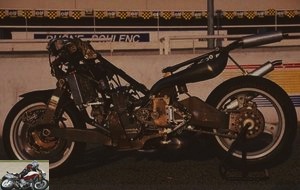 The use of magnesium reduced the weight to 118 kg
The use of magnesium reduced the weight to 118 kg
In this way, it can be said that ELF has come full circle since de Cortanze had also used magnesium castings extensively on the ELFe endurance sports car, in particular for the swing arms. At the same time, these changes also pushed to keep the same NSR500 engine from 1987, rather than the new and more powerful 88 that Honda was providing for free. The lead time for the models for the magnesium castings prompted the team to use the engines they already had, rather than waiting for those that would arrive only a short time before the start of the season. Because ELF wanted to be able to compete in all the Grands Prix. This season is already defined as the last of the project. It may have been a pragmatic decision, but it also means that the real value of the ELF5 will always remain a mystery due to the handicap of this one year old engine and far less powerful than the last factory V4s..
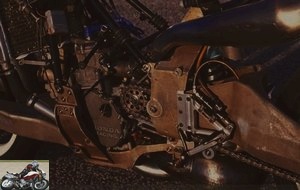 Honda NSR500 V4 engine is the same as ELF4
Honda NSR500 V4 engine is the same as ELF4
What could be done instead was to change all front and rear suspension settings quickly and easily. That as well as the caster angle, the wheelbase, the drag, the ground clearance or the weight distribution: everything was easily modifiable according to the needs of the pilot..
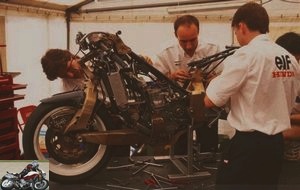 The ELF5 stands out above all for its VGC system and its numerous adjustment possibilities.
The ELF5 stands out above all for its VGC system and its numerous adjustment possibilities.
Ron Haslam :
Riding the ELF for three seasons taught me more about motorcycle setup than the rest of my racing career. When you go to a new circuit there is so much you can do to try to get the most out of the handling of the bike or the tires and it can all be done very quickly compared to other bikes. It’s more like a two-wheeled racing car. But I think there are one or maybe two big drawbacks. First, the chassis has always been designed around the engine, instead of having an engine built the way one would like to achieve the ideal chassis setup. Second, we have never made specific tires for the ELF. So we had to settle for what was developed for regular motorcycles and that was a big deal. I always had to use a bias tire up front because the radial didn’t provide any warning when slipping and it certainly slowed us down a lot. "
 The ELF5 will have driven only one Grand Prix 500 season
The ELF5 will have driven only one Grand Prix 500 season
Another compromise was made in the design of the front brake, after overheating problems on the ELF4 with the wraparound position of the disc inside the front wheel. This caused disc warping and far from constant performance. This is about the most terrifying thing you can think of in the world of Grand Prix where you need total commitment and where you have to be able to brake instinctively and know that the response will always be constant and totally effective. Experiments with AP-Lockheed’s carbon brake configuration have not solved the problem. For the ELF5, the team used a pair of 310mm steel floating discs each gripped by a four-piston caliper specially manufactured by Nissin at Honda’s request. This gave Ron reliable brakes, while significantly increasing the unsprung weight. But the bite was still not as strong as on a good modern racing brake.
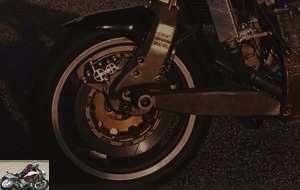 After the overheating problem of version 4, Honda ordered special brakes from Nissin for the ELF5
After the overheating problem of version 4, Honda ordered special brakes from Nissin for the ELF5
In the saddle
Built around the NSR V4 engine that brought Wayne Gardner to the title in 1987, the ELF5 is nonetheless totally different from its Honda cousin, not just visually, but also in the riding position and the way it drives. For starters, the driving position is more extreme than that of the NSR. We are aware of being seated much further forward, with the chin practically rubbing the magnesium molding of the steering gear. According to Ron Haslam, this was an evolution from previous versions:
On the ELF3 we had a traction problem, although it behaved well. This made the rear wheel slide too easily in the corners. But on ELF4, they went too far in the other direction and we ended up with a steering problem because the weight was not in the right place. So on the ELF5 we tried to balance and pretty much succeeded, although that meant moving the riding position further forward to get more of my own weight off the front wheel. "
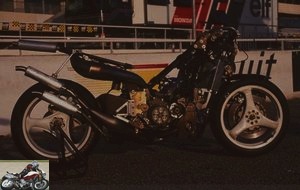 The position on the ELF5 is much more forward than on the NSR500
The position on the ELF5 is much more forward than on the NSR500
Thus, the static weight distribution is fairly standard with 53/47% without the pilot. The forward bias is much greater when riding the ELF5.
Test
After a careful first lap, I accelerate a bit in the second, but not enough for the ELF to behave as I expected after having driven so many of its elders. OK, if you’re not firm enough here, the bike tells you what to do. That will not happen, declared the ELF which quickly made me understeer out of the fast curve of Signes at the exit of the straight line of the Mistral! Fortunately, after running Paul Ricard regularly over the years, I knew what looked like a smooth, painted surface was actually surprisingly grippy. So no need to panic just yet, it’s just a surprise. The panic came a few hundred meters further, in the tight left, after the Pif-Paf. A tight trajectory is necessary here. So you have to brake late and far, tip the bike and prepare to open the throttle wide. Only, the ELF5 was not turning correctly, sending me off track again before I managed to catch up and get back on the normal course. I was perplexed … and disappointed.
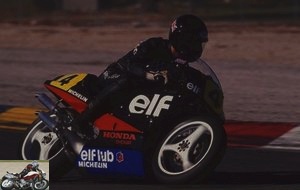 The ELF5 is not easy to take around the bends
The ELF5 is not easy to take around the bends
I then returned to the pits to get some great advice from Ron Haslam:
Don’t worry, she understeers a lot. You can’t rush into a turn, go far, brake late, and slide the rear wheel to help you through a tight turn like other GP bikes do today. This is the way Americans ride. With the ELF5, you have to ride it European-style and work on the bank angle to help you take the turn. Because if you try to ride it like a conventional motorcycle, it feels heavy and doesn’t respond. You have to take more angle to make it turn well. Try rubbing the fairing and you will be fine !
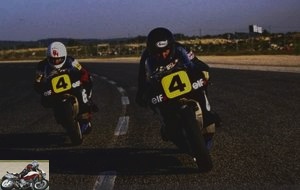 Ron Haslam (left) was present at Le Castellet to provide advice
Ron Haslam (left) was present at Le Castellet to provide advice
Mr. Haslam’s unique approach seemed a little intimidating. But I found myself following it, at least partially, on a few following laps. And, of course, it worked.
It is then necessary to take courage with both hands to attack this fast curve to the right more inclined and to use the whole track to enter and exit in a very classic way to reach the point of chord as would have done it John Surtees. The direction of the ELF then becomes neutral, although still heavy. On the other hand, despite the very short wheelbase of 1.375 mm (for a V4!), The ELF does not like to change course once engaged in the curve, which must have made Ron Haslam suffer that year when he caught up with latecomers. It is stable, but not at all agile, unlike the heavier ELF3 but the lighter steering which seemed much more responsive and maneuverable. This explains the unique styling Ron Haslam adopted that season to meet the demands of the bike, taking long, smooth paths and leaning the bike more than anyone else in the 500 GP class..
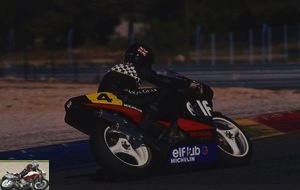 Even if handling improves with the right technique, the steering remains heavy.
Even if handling improves with the right technique, the steering remains heavy.
What you get in return for this lack of handling is hyper-stability under braking, an asset that has in the past caused problems in its wake. Due to the constant steering geometry of this center hub design, one can brake harder and later with the ELF5 compared to any conventional motorcycle. You just have to convince yourself that it is really possible. Having flown and raced many machines of this type before, I didn’t need to persuade myself as much as the guy behind me, although I can’t claim to have exploited the advantages of the ELF as well as I did. Rocket Ron did. But once I figured out how to ride the ELF5, I found that putting the bike on the angle sooner than you would with another machine didn’t compromise braking performance, for the simple and good. The reason is that you can brake very hard while continuing to turn, without the suspension ceasing to operate. I noticed how Ron had allowed a small, but noticeable, amount of forward dive under braking to give himself the "feel" that would otherwise have been missing. Center-hub motorcycles have a curiously absent braking feel if you don’t, giving the impression that the brakes aren’t working when they are actually acting. On the ELF5, this "problem" was eradicated via a small modification of the steering geometry (hence the name VGC).
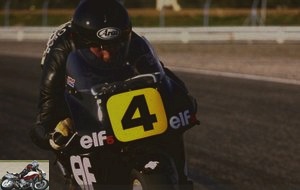 If the braking is very stable, it lacks a bit of bite compared to competing motorcycles of the time
If the braking is very stable, it lacks a bit of bite compared to competing motorcycles of the time
Conclusion
The dream of creating what Serge Rosset called an “à la carte” motorcycle, a motorcycle that can be easily modified to suit the tastes of anyone who rides it, has been fulfilled with this motorcycle. It should be noted that in 1988, the 1987 NSR-powered ELF5 and Ron Haslam beat the conventional NSR500’s lap times of 87 by using the same engine and tires on each circuit. In itself, this justified Rosset’s claim that the ELF5 was now able to improve the performance of comparable conventional motorcycles. Too bad the ELF project ended at the same time that this goal was reached !
 The ELF5 is the last of a line which will have finally succeeded in reaching its objectives.
The ELF5 is the last of a line which will have finally succeeded in reaching its objectives.
Strong points
- Braking stability
- Geometry settings
Weak points
- Understeer
- Agility
The technique of ELF motorcycles
Related articles
-
The Japanese endurance Bimota based on Honda CBR900RR Fireblade 4 cylinders in line, 944 cm3, 177 hp, 163 kg TSR Honda AC90M. Who does this name mean?…
-
Offenstadt Kawasaki 750 sports bike test
The H2 Monocoque Pilot-engineers are a rare breed, especially those who are equally expert in both disciplines and able to design innovative and unique…
-
Sports test Ducati 750SS Moreparts
The Desmo of Mike Hailwood’s comeback 90 ° desmo V-Twin, 749 cm3, 73 hp, 180 kg dry Most road racing enthusiasts will tell you that Mike Hailwood did not…
-
Sports test Chevallier Honda RS500
Against all odds V3 at 90 °, 499 cm3, 125 hp, 116 kg dry Beating the Japanese factory teams by winning Grand Prix with motorcycles you yourself built in…
-
Moto Guzzi 500 Bicilindrica sports test
The Methuselah of motorcycle racing 120 ° V-twin, 494 cc, 52 hp, 145 kg Birthday ! Moto Guzzi celebrates its 100th anniversary this year! In contrast to…
-
The European Grand Prix prototype 108 ° V4, 499 cc, 192 hp at 12,500 rpm, 129 kg We find it normal to see Ducati, KTM and Aprilia currently competing in…
-
French watch or Gallic genius ? 128 hp Honda Moto2 engine, parallelogram suspension front axle, adjustable geometry, solid 7075 T6 aluminum chassis, 154…
-
Dick Mann’s motorcycle victorious at the 1971 Daytona 200 The 200 miles of Daytona are one of the legendary races where talented riders on the handlebars…
-
The first two-stroke of the Grands Prix 500 3-cylinder engine, 498 cm3, 82 hp and 59 Nm, 134 kg dry Ironic, really. Of the four Japanese manufacturers,…
-
One of a kind V-Twin demodue, 904 cm3, 75 hp and 76 Nm, 186 kg dry, 2,000 copies produced You know you’ve been successful as a motorcycle designer when…
The comments regarding the quality of the fork may need to be weighed. Indeed, if the fork of this version is the same as that of the 2V version (and it seems to me that it is), then the author of this article missed the fact that the rebound AND compression settings are separated. One per scabbard: compression on the left and rebound on the right. So if we always try to regulate the two together we will behave … weird. Especially since the beauty is sensitive to these settings